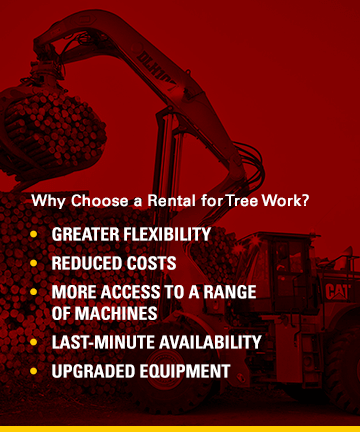
The Ultimate Guide to Tree Work
Tree work spans everything from pruning branches for safety to large-scale logging operations. Landscapers, arborists and forestry crews all depend on specialized tree work equipment to handle different tasks. This guide explains what tree work is, the equipment that makes it possible and why renting can be a smart choice.
What Does Tree Work Involve?
Tree work includes trimming, pruning, felling, thinning and even transplanting them. Each service has its own goals: improving appearance, clearing land for construction, protecting people and power lines, or supporting forestry harvests. Whatever the application, the right equipment ensures the job is done safely and efficiently.

What Equipment Do You Need for Tree Work?
Here are the nine most common types of tree work equipment, when to use them and what to consider before choosing.
- Brush chippers reduce branches, limbs and small trees into chips that are easy to haul or sell as mulch. Smaller units work well for residential cleanup jobs, while commercial models handle trunks up to 20 inches. Chippers improve site safety by keeping debris under control.
- Felling head attachments help the equipment cut and gather trees, speeding up clear-cutting and thinning. They’re popular in logging because they help control the direction trees fall, helping improve safety and reduce damage to surrounding trees.
- Tree spades make it possible to relocate rather than remove trees. By lifting the root ball intact, they preserve the tree for replanting. They’re widely used in nurseries and landscaping when clients want to save mature trees or reposition them for design or safety reasons.
- Harvester heads cut, delimb and help position logs. This efficiency makes them standard in timber operations.
- Both walk-behind trenchers and ride-on trenchers cut trenches and heavy roots. Walk-behind trenchers are compact, suited for landscaping or utility jobs in tight spaces. Ride-on trenchers dig deeper — up to five feet — and are powerful enough for commercial or forestry work. They’re often used alongside other machines for site prep.
- Stump grinders remove stumps after felling, leaving land clear for planting or construction. Small models fit through gates for yard work, while larger grinders mounted on vehicles handle forestry stumps. By grinding below grade, they eliminate tripping hazards and prevent regrowth.

Why Rent Tree Work Equipment?
Renting instead of buying offers several advantages:
- Flexibility: Rent for one job or season and return equipment when you’re done.
- Lower costs: Avoid large upfront purchases and storage or maintenance expenses.
- Variety: Access different machines as projects demand.
- Speed: Get rentals quickly to handle unexpected challenges.
- Access to the latest technology: Rental fleets include upgraded, efficient models that boost productivity and comfort.
Where Can You Find Tree Work Rentals?
The Cat® Rental Store carries a wide range of tree work equipment and provides expert advice to match the right machine to your job. Contact your local dealer or find the Cat Rental Store near you to explore options and get equipment delivered to your site.
